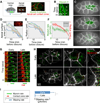Triggering a cell shape change by exploiting preexisting actomyosin contractions
- PMID: 22323741
- PMCID: PMC3298882
- DOI: 10.1126/science.1217869
Triggering a cell shape change by exploiting preexisting actomyosin contractions
Abstract
Apical constriction changes cell shapes, driving critical morphogenetic events, including gastrulation in diverse organisms and neural tube closure in vertebrates. Apical constriction is thought to be triggered by contraction of apical actomyosin networks. We found that apical actomyosin contractions began before cell shape changes in both Caenorhabitis elegans and Drosophila. In C. elegans, actomyosin networks were initially dynamic, contracting and generating cortical tension without substantial shrinking of apical surfaces. Apical cell-cell contact zones and actomyosin only later moved increasingly in concert, with no detectable change in actomyosin dynamics or cortical tension. Thus, apical constriction appears to be triggered not by a change in cortical tension, but by dynamic linking of apical cell-cell contact zones to an already contractile apical cortex.
Conflict of interest statement
The authors declare no conflicts of interest.
Figures




Comment in
-
Cell biology. Embryonic clutch control.Science. 2012 Mar 9;335(6073):1181-2. doi: 10.1126/science.1220388. Science. 2012. PMID: 22403380 No abstract available.
References
-
- Friedl P, Gilmour D. Collective cell migration in morphogenesis, regeneration and cancer. Nat Rev Mol Cell Biol. 2009;10(7):445–457. - PubMed
-
- Weijer CJ. Collective cell migration in development. J Cell Sci. 2009;122(Pt 18):3215–3223. - PubMed
-
- Odell GM, et al. The mechanical basis of morphogenesis. I. Epithelial folding and invagination. Dev Biol. 1981;85(2):446–462. - PubMed
Publication types
MeSH terms
Substances
Grants and funding
LinkOut - more resources
Full Text Sources
Other Literature Sources
Molecular Biology Databases

